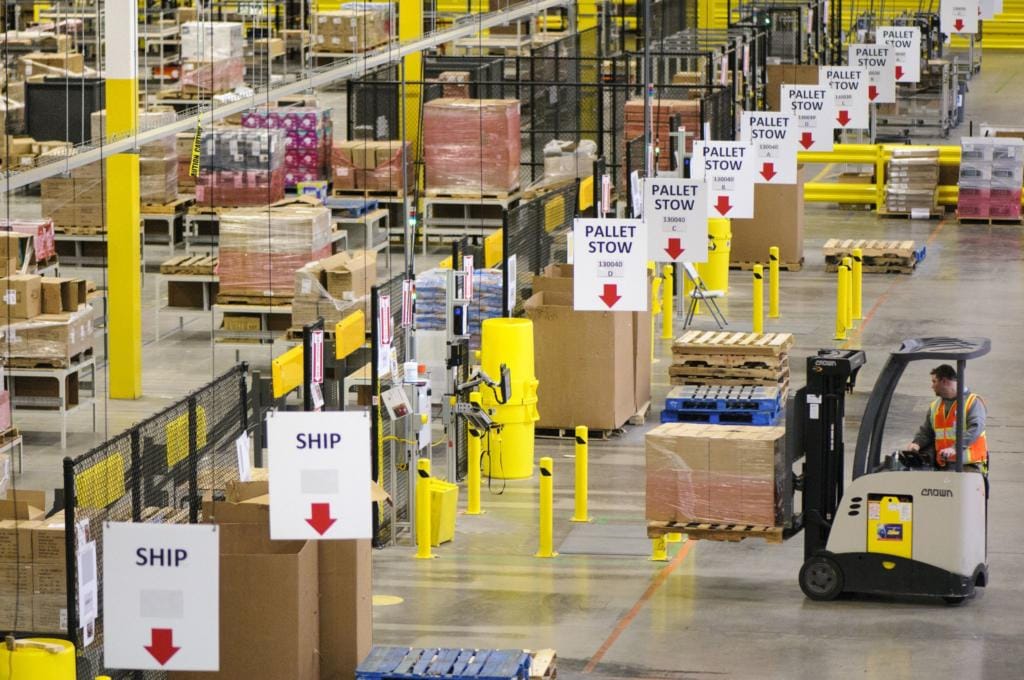Amazon is violating the law by pressuring warehouse employees to work at speeds that exacerbate injuries without adequate time to recover, state safety regulators concluded earlier this month after an inspection of the commerce giant’s DuPont, Pierce County, fulfillment center.
Regulators found a “direct connection” between the incidence of injuries at the warehouse and Amazon’s expectation that warehouse employees “maintain a very high pace of work” or else face discipline.
“The employer’s current approach has resulted in hazardous exposures in the workplace,” the citation states.
The inspection’s findings complicate the company’s effort to brand itself “Earth’s Safest Place to Work” and validate what Amazon employees have said for years: Amazon’s requirement that employees keep up with hourly targets for tasks like unloading pallets, stowing merchandise and packing boxes has created an injury crisis at the retail behemoth’s hundreds of U.S. warehouses.
Muscle, joint and nerve injuries caused by the repetitive rhythms of the warehouse have left some Amazon employees without work and in constant pain. Employees unable to meet the targets — known in Amazon parlance as “making rate” — can be fired.
An investigation last year by Reveal from The Center for Investigative Reporting and published by The Seattle Times found that Amazon misled the public and lawmakers about the extent of injuries at its warehouses. Workers at Amazon fulfillment centers were getting seriously hurt at rates more than double the industry average, Reveal found, with workers at Amazon’s DuPont facility injured at a higher rate than at any other large Amazon warehouse in the U.S.
Reveal’s reporting, in part, prompted the inspection by Washington’s Department of Labor and Industries, according to files obtained by Reveal and The Seattle Times. The agency is the state counterpart of the federal Occupational Safety and Health Administration.
This type of citation is rare and significant, said Debbie Berkowitz, a former federal OSHA official and current director of the worker health and safety program at the National Employment Law Project.
“This is groundbreaking. It is the first time that OSHA has found the company in violation of the law for failing to protect workers because of their incredibly high-paced jobs,” Berkowitz said. “It would be in Amazon’s interest to really start implementing real safety programs, not just public relations efforts.”
The inspection, which was conducted in January, resulted in a $7,000 fine, according to a copy of the agency’s assessment. The amount is the maximum for a serious citation, according to LNI spokesperson Tim Church.
Though Amazon often touts its safety initiatives in response to criticism, the citation states that the company failed to follow its own ergonomics program.
The workplace regulator also found that Amazon “did not implement everything reasonably necessary” to protect workers from muscle and joint injuries. It found workers repeatedly lift loads of up to 49 pounds by hand, and use highly repetitive motions to unpack and pack items.
The company is also required to take steps to lessen the risk of injuries at the warehouse. The agency recommended a list of changes, including setting the pace of work based on an ergonomic risk analysis. It said Amazon must submit a detailed written plan for fixing the problem and provide quarterly updates on its progress.
Amazon spokesperson Kelly Nantel said the company intends to appeal the citation.
“Nothing is more important than the health and safety of our teams,” Nantel said in a statement.
Amazon declined to answer specific questions, but said it continues to invest in safety training and education programs and is seeing improvements through programs such as guided wellness exercises and changing workstation design.
In the wake of a high-profile, though ultimately unsuccessful, union drive at an Amazon facility in Alabama spurred in part by workers’ safety concerns, Amazon has said it’s focusing renewed attention on workplace injuries.
The company last week committed to halving injury rates at its warehouses, part of Amazon founder Jeff Bezos’ recent commitment to turn Amazon into “Earth’s Best Employer and Earth’s Safest Place to Work.” Amazon has rolled out a suite of new safety programs that it says have been proven in pilot programs to lower injury rates. They include “AmaZen” mindfulness exercises and signs encouraging healthy eating.
None of Amazon’s publicized safety initiatives, however, address the core issue driving the injuries: the pace of warehouse work. Amazon has previously touted its investment in workplace safety and what it says is a strong record of keeping workers healthy, but injury rates at Amazon fulfillment centers rose between 2016 and 2019, Reveal found.
At the heart of the injury toll at Amazon’s warehouses was the company’s relentless focus on speeding processes to get more packages to customers as quickly as possible, Reveal’s reporting showed. Injuries were higher at robotic warehouses and spiked during peak periods such as Prime Day.
In Washington, Amazon workers were getting hurt so often that state regulators last year decided to charge the company a higher rate on its workers’ compensation premiums than other warehouse operators. The risk of working in an Amazon facility, regulators found, was higher even than working in the historically hazardous logging or meatpacking industries.
During the January inspection, some workers at the DuPont warehouse told inspectors that they were still expected to make rate even when injured. While some supervisors will allow injured workers to move to less strenuous jobs, other injured workers are told to “take a pill” and keep working, multiple employees reported.
“They put pressure on you to make #’s for the day,” an inspector recorded one Amazon worker, who reported having trouble keeping up because of carpal tunnel syndrome, saying in an interview. “I’ve thought about leaving because of injuries.”
Amazon’s rate expectations are geared towards the company’s youngest, fittest workers, another employee told the inspector: “I’m 56 years old. I need work but I don’t want to get hurt.”
Reveal from The Center for Investigative Reporting is a nonprofit newsroom. Sign up for its newsletter.



